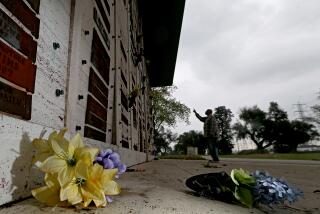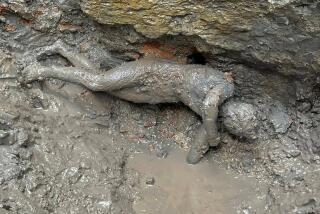Italian Site Yields Treasures, but Looters Bedevil Scientists : Etruscan Tombs Lure Archeologists, Thieves
- Share via
TREVIGNANO, Italy — Seven centuries before the birth of Christ, a city of farmers and fishermen flourished here on the shores of a volcanic lake about 50 miles north of Rome. Generations of townspeople burrowed into soft hillside rock to make tombs for their dead.
The accidental discovery last summer of this ancient Etruscan necropolis is proving to be a textbook example of the triumph and trauma of modern archeology in a country where precious fragments of yesterday are often no farther than the backyard.
“How lovely,” said archeologist Rodolfo Carmagnola, who was on his hands and knees over a 2,700-year-old skeleton, brushing with a surgeon’s care at pottery, a bronze cup and a javelin consigned to eternity with the young man who apparently had once owned them.
Tombs Looted
“What a shame,” said Ida Caruso, director of archeology at the Villa Giulia Museum, which houses the world’s greatest collection of Etruscan antiquities. She gestured with disgust up the hillside at nine other tombs that had been looted over the previous few months.
“I am ruined,” said Carlo Cicchinelli, a Rome builder who bought the hillside parcel planning to put up a small apartment building.
Cicchinelli, whose company builds about a dozen apartment buildings a year in a country where housing is at a premium, is out of luck. By law, he cannot turn a spade until scientists have finished evaluating the find. And they will not be finished soon. The Italian government agency charged with development and protection of the site is out of money.
Needs and Greed
There is not much common ground for the needs, or the greed, of modern man and his ancestors. It is an oft-told tale, Caruso said sadly, a variation on an Italian theme that is heard dozens of times a year.
“Disgracefully, what has happened here is all too common,” she said. “At every dig, we lose a lot. The thieves always get there first. Then, there is never enough money.”
What is particularly irksome here is that the discovery may be of great importance, both in size and significance. It could provide new insight into Etruscan life for scholars from around the world.
The Etruscans, conquerors of uncertain origin but advanced culture, dominated much of central Italy before the rise of Rome. The best testimony to a rich, shrouded, 1,000-year civilization is found in Etruscan tombs.
Gloria Adinolfi, one of the archeologists working at the site, says the tombs, each with an empty anteroom and a burial chamber carved painstakingly from the rock, date to the 7th Century BC. The hillside site is now covered with small apartment buildings and an olive grove, and it is not clear how far the necropolis extends, but there is strong suspicion it is the remnant of a major city.
“Local lore speaks convincingly of three kilometers of tombs, which would suggest that this was both an important and a wealthy Etruscan center,” Adinolfi said.
Caruso, letting her imagination range a bit, wondered if Trevignano, now a sleepy lakeside settlement of 5,000, might have been the site of the city of Sabate, known to history only through legend.
Of even greater excitement to the scientists than the tombs themselves is the fact that they appear to have been dug into the remains of an older settlement.
“What we have here are some of the earliest signs of urbanization,” archeologist Marco Pacciarelli said. “This was apparently once a village that was abandoned and then several hundred years later became the site of a major Etruscan city.”
That is a lot of history on a would-be building site perhaps 100 feet wide and flanked by apartment houses whose residents, Caruso says sarcastically, “saw nothing, know nothing, took nothing.”
“What should I do,” she went on, “get a warrant? Whatever was taken, by whomever, is probably already in Switzerland.”
The drama began near the end of July, when builder Cicchinelli hired a subcontractor to dig a foundation for what was to have been apartments for sale as weekend homes.
A bulldozer operator promptly turned up more than earth, yet he kept on with the work, and the walls of a number of tombs bear mute testimony to his skill. The bulldozer operator and the subcontractor both face imprisonment, Caruso said.
Then, after dark, came the free-lance diggers.
‘Quick with Pick and Shovel’
“They are quite expert in their own way--very quick with a pick and shovel,” Carmagnola said with a sigh. His own tools include scalpels, dentist’s picks, fine whisk brooms, chemical fixers to protect metal as it is exposed to air and a sieve for the dirt removed a spoonful at a time. “In a single night,” he said, “they can strip pottery from the head of a tomb, drinking vessels from the foot and rummage around for jewelry.”
The clamor never disturbed the neighbors, but word that there was something more interesting to do at night than watch television quickly seeped through the village. An archeologist working on a nearby project got wind of the find and called the police.
The thieves were gone by then, of course. They have not been back since, now that a fence has been put up and a night watchman assigned. But one local man with a digger’s reputation occasionally stops by to chat with the scientists about their progress.
“There are a lot of protection laws, but to arrest anybody you have to find them with their hands in the tomb or artifacts in their possession,” Pacciarelli said.
When the discovery came to light, builder Cicchinelli, who paid about $120,000 for two parcels of land totaling 4,500 square meters, came hurrying from Rome to consult with the archeologists.
“I was quite happy they had made such a discovery--for them,” he said. “At first I offered to finance the dig myself, but the cost is enormous, and I had no idea how slow it would be. There are a lot of digs around Trevignano that have started and simply run out of steam. Now I have creditors at the door, no means to pay them and five workers who, like me, are out of work. I doubt I’ll ever see anything back in damages.
“I’m an outsider. The other places are all owned and built by locals who do the work themselves, build faster and say nothing. There’s a building next door whose garage is an Etruscan tomb.”
For the moment, science holds the Etruscan hill. But with the money gone, its grasp is both tenuous and perilous.
More to Read
Sign up for Essential California
The most important California stories and recommendations in your inbox every morning.
You may occasionally receive promotional content from the Los Angeles Times.













